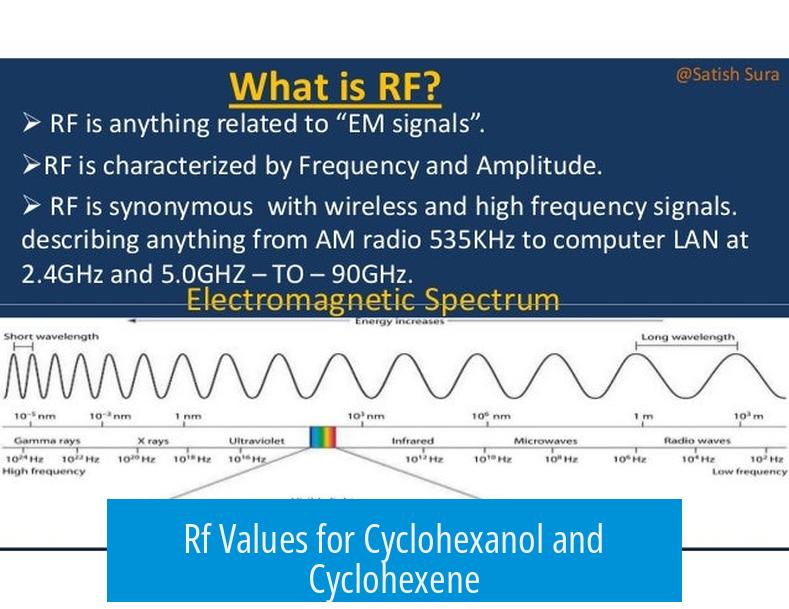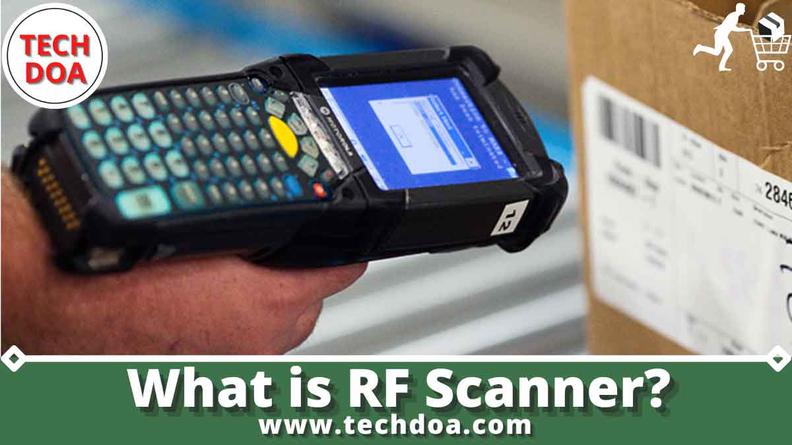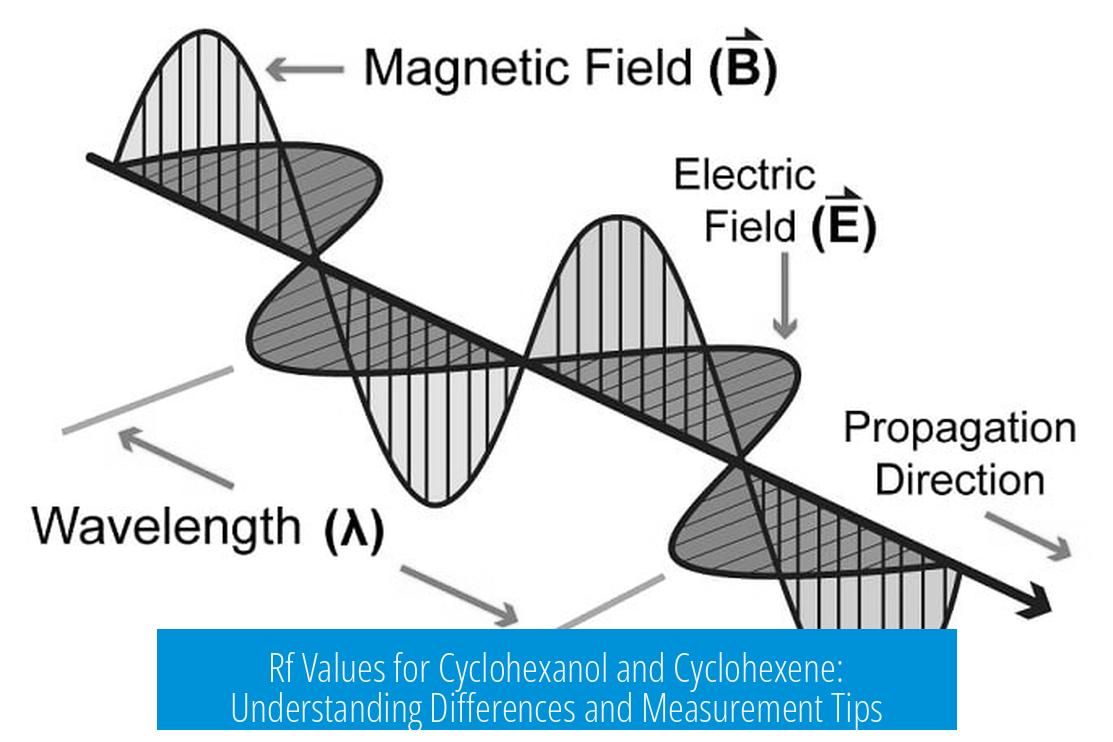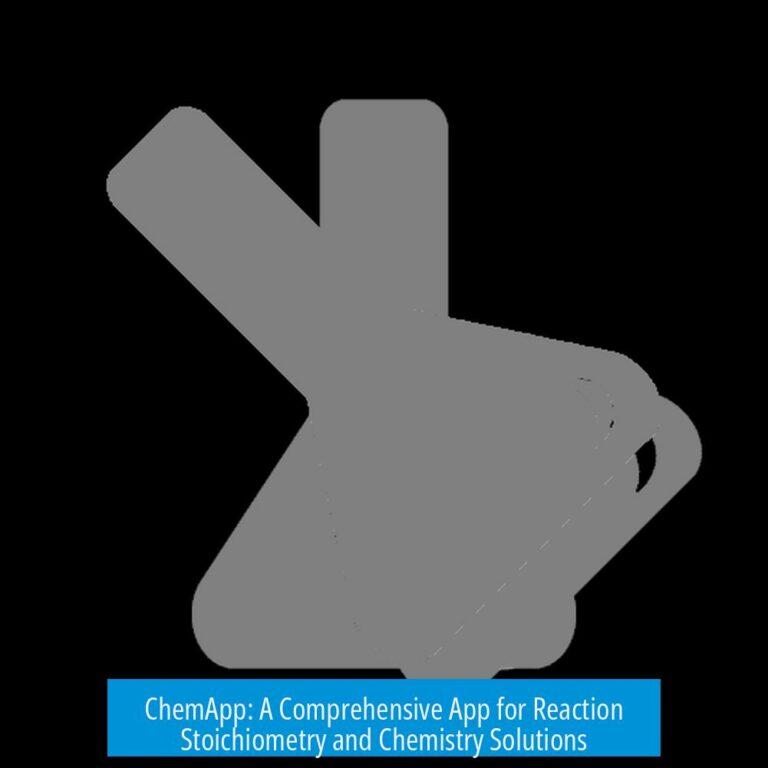Rf Values for Cyclohexanol and Cyclohexene

The Rf values for cyclohexanol and cyclohexene differ due to their distinct polarity and interactions with the stationary phase in thin-layer chromatography (TLC). Cyclohexanol, being an alcohol, is more polar than cyclohexene, an alkene. This polarity difference influences their retention on the silica gel, generally resulting in a lower Rf for cyclohexanol compared to cyclohexene under similar solvent conditions.
Understanding Rf Values
The retention factor (Rf) indicates a compound’s relative distance traveled on a TLC plate. It is calculated by dividing the distance traveled by the compound’s spot by the distance traveled by the solvent front:
Rf = (Distance traveled by compound) / (Distance traveled by solvent front)
A compound with a higher affinity for the stationary phase moves slower and has a lower Rf. Conversely, compounds less retained travel further and have higher Rf values.
Factors Influencing Rf Differences Between Cyclohexanol and Cyclohexene

- Polarity: Cyclohexanol contains a hydroxyl (-OH) group that forms hydrogen bonds with the silica gel, increasing retention and lowering its Rf value.
- Non-polarity of Cyclohexene: Lacking polar functional groups, cyclohexene interacts weakly with silica, resulting in higher mobility and a greater Rf.
- Solvent System: The choice and polarity of the mobile phase solvent also affect Rf values significantly. More polar solvents reduce overall retention, increasing Rf values.
Typical Rf Values
Though exact Rf values depend on the solvent used, typical experiments yield:
| Compound | Typical Rf Range (in non-polar/polar solvent mixtures) |
|---|---|
| Cyclohexanol | 0.2 – 0.4 |
| Cyclohexene | 0.5 – 0.7 |
This difference allows for effective separation of the two compounds by TLC under proper conditions.
Practical Tips for Measuring Rf Values

- Mark the baseline and solvent front immediately after removing the TLC plate to prevent evaporation errors.
- Run the solvent approximately 0.5 cm from the top to ensure accurate measurement and good separation.
- Use pencil marks to avoid interference with detection.
- Repeat measurements as slight variations may occur due to adsorbed water or measurement error.
Summary
- Cyclohexanol has a lower Rf than cyclohexene due to its higher polarity and interaction with silica gel.
- Rf values depend on solvent choice and should be considered approximate.
- Typical Rf values for cyclohexanol range from 0.2 to 0.4; for cyclohexene, 0.5 to 0.7 under similar conditions.
- Careful marking and solvent control are key for accurate Rf measurement.
Unlocking the Mystery: Rf Values for Cyclohexanol and Cyclohexene

Ever stared at a thin layer chromatography (TLC) plate and wondered, “What do those R_f values mean for compounds like cyclohexanol and cyclohexene?” You’re not alone. This post dives into Rf values for cyclohexanol and cyclohexene, cutting through the confusion with some good old chemistry know-how—and a touch of humor.
Let’s start with the basics before zooming in on these two cyclo-compounds you might be wrestling with in your organic chemistry lab.
What Exactly Is an Rf Value?
The Retention factor, shortened as R_f, is a simple yet powerful number chemists use to describe how far a compound travels on a TLC plate relative to the solvent front. Here’s the magic formula:
R_f = (distance traveled by the compound) ÷ (distance traveled by the solvent front)
Imagine you drop a spot of cyclohexanol near the bottom baseline of the TLC plate and then let the solvent run. You track how far the solvent moves from the baseline. Then, measure how far your cyclohexanol spot moves. Those two numbers form your R_f value. Simple, right?
For example, an R_f of 0.55 means the compound moved 55% as far as the solvent front, just a bit more than halfway up the plate.
Why Can’t You Look Up Exact Rf Values for Cyclohexanol and Cyclohexene?
You might be itching to find a definitive R_f number for these compounds and think, “Why does Google keep giving me vague answers?” The honest truth is that R_f values aren’t fixed constants like atomic weights. They change based on factors like solvent type, TLC plate adsorbent, humidity, and even the quantity of your sample. No lab coconut water or soft music will help here, unfortunately.
In fact, the provided data notes there’s no explicit R_f for cyclohexanol and cyclohexene. Instead, the takeaway is: R_f values serve as approximate identifiers, not absolute fingerprints.
How Do Cyclohexanol and Cyclohexene Differ on TLC Plates?
This is where chemistry’s personality shines. Cyclohexanol and cyclohexene have different functional groups—cyclohexanol sports an –OH (alcohol), while cyclohexene features a C=C double bond (alkene). This difference impacts how they interact with the TLC plate and solvent.
- Cyclohexanol is more polar because of its alcohol group. It tends to stick more strongly to the polar silica gel adsorbent on TLC plates, resulting in a lower R_f value (it doesn’t travel as far).
- Cyclohexene is less polar, so it interacts less strongly with the stationary phase and usually moves further up the plate. This gives cyclohexene a higher R_f value compared to cyclohexanol.
In practical lab tests, you might see cyclohexanol with an R_f around 0.3 to 0.5 in a moderately polar solvent system, whereas cyclohexene’s R_f could be anywhere from 0.6 to 0.8. But remember, these are ballpark figures and vary with experimental conditions.
How to Measure Rf Values Accurately Like a TLC Pro
Now, measuring distances might sound trivial, but precision matters. Here are pointers to nail that R_f:
- Mark the baseline clearly: Use a pencil to draw where you spot your compound. Pen ink hates TLC!
- Run the solvent: Let it travel but avoid it reaching too close to the plate’s top. About 0.5 cm from the edge is the sweet spot.
- Mark the solvent front immediately: This is the fastest way to make sure you remember exactly how far your solvent went before it evaporated (which it loves to do).
- Measure accurately: Use a ruler to find distance from the baseline to the center of your compound’s spot, and in a separate measurement from the baseline to solvent front.
- Calculate: Divide compound distance by solvent front distance.
Keep a cool head because small errors are normal—and R_f values are approximate. The key is consistency if you compare spots across runs or labs.
Why Do Tiny Factors Change Rf Values?
Here’s a fun chemistry kicker: R_f values can wiggle around thanks to factors beyond your control:
- Humidity and adsorbed water: Silica gel isn’t just a solid; it adsorbs water from the air. This changes the plate’s polarity.
- Solvent mixtures: Different solvent ratios create different ‘mobile phases’ that affect compound movement.
- Amount spotted: Too much compound can cause tailing or distorted spots.
So yes, even your lab coat’s pocket humidity level can be a suspect.
Practical Tips to Distinguish Cyclohexanol and Cyclohexene on TLC
Here’s a quick, foolproof experimental strategy for your next TLC run:
- Use a moderately polar solvent system: Something like 30% ethyl acetate in hexane can give good separation.
- Run standards: Spot pure cyclohexanol and cyclohexene on the same plate along with your sample for side-by-side comparison.
- Check spot shape and color: Maybe spray with a visualization reagent (like KMnO4 or anisaldehyde). Cyclohexene and cyclohexanol react differently here.
This way, your R_f readings become more meaningful and less of an abstract number.
Final Thoughts: Rf Values Are Your Guide, Not Your Gospel
In summary, Rf values measure how far compounds like cyclohexanol and cyclohexene travel relative to the solvent—or how much they “hang back” due to polarity and interaction with the TLC plate. Cyclohexanol’s polarity usually leads to lower Rf values, while cyclohexene moves further and shows higher Rf values on typical plates.
TLC and R_f are more art than strict rulebook—slight variations and approximations abound. The secret is consistent technique and clear documentation. And when in doubt, run your own standards side-by-side. That’s lab wisdom seasoned chemists swear by.
Next time you get your TLC plate out, don’t just chase numbers. Think of R_f as a chemical footprint telling the story of each molecule’s journey. What could be more intriguing?





Leave a Comment